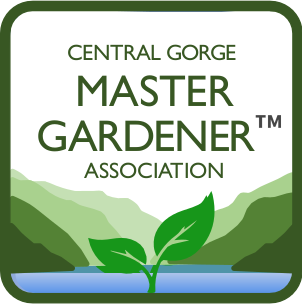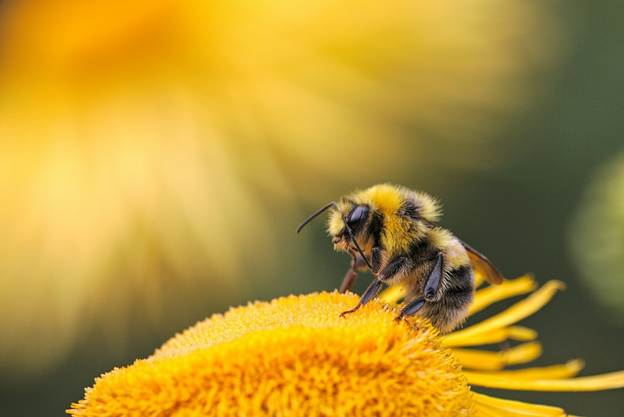Pollinator Gardens: Creating Safe Forage for Bees, Butterflies, and Other Pollinators
by Sarah Smeby, OSU Hood River County Extension Central Gorge Master Gardener Volunteer
In the Columbia River Gorge, native pollinators include a variety of bees (like bumblebees, honeybees, and various wild bee species), butterflies, moths, flies, beetles, wasps, small mammals, and hummingbirds. Recently, concern about the decline of pollinator populations has grown. This is driven by factors such as habitat loss, pesticide use, climate change, and disease. Pollinator gardens offer a simple way to support these vital creatures.
What is a Pollinator Garden?
A pollinator garden is a space specifically designed to attract and support pollinators. A pollinator garden focuses on creating a welcoming environment for the insects and animals that assist in the pollination of plants. These gardens typically feature a variety of flowering plants that provide nectar and pollen, as well as shelter and nesting opportunities for pollinators.
The Importance of Pollinators
Pollinators are essential to biodiversity and food security. They are responsible for pollinating roughly 75% of flowering plants and around 35% of the world’s food crops. Without them, many plants would be unable to reproduce, leading to a significant reduction in the variety of fruits, vegetables, nuts, and seeds available to humans and other animals. This includes crops like apples, peaches, blueberries, pumpkins, tomatoes, and even coffee.
Pollinators also contribute to the health of ecosystems. They help maintain plant diversity, which in turn supports wildlife by creating habitats in the way of food and shelter.
Pollinator populations have seen a decline in number due to several factors:
- Habitat Loss: Urbanization, agricultural expansion, and deforestation have all led to the destruction of natural habitats for pollinators. As natural landscapes are replaced with concrete, grass, and monoculture crops,pollinators are left with fewer places to live and find food.
- Pesticides: The widespread use of chemical pesticides in agriculture and landscaping has been linked to the decline in pollinator populations. These chemicals can be toxic to pollinators, and even small amounts can disrupt their ability to forage, navigate, and reproduce.
- Climate Change: Shifting weather patterns, temperature changes, and extreme weather events are altering the timing of blooming flowers and the availability of food sources. Climate change also affects the range and distribution of pollinator species, making it harder for them to find suitable habitats.
- Disease and Pests: Pollinators, particularly honeybees, are vulnerable to diseases and pests like the Varroa mite, which can weaken colonies and reduce their ability to pollinate.
One way individuals can help combat these challenges is by creating pollinator gardens that provide a safe, healthy environment for these critical species.
How to Create a Pollinator Garden
Creating a pollinator garden is easier than you might think. From growing a few potted plants on a balcony to cultivating acres of wildflowers, your options are nearly endless! Here are some helpful ways to get started:
1. Choose your plants
The first step in designing a pollinator garden is selecting plants that will attract and nourish pollinators. Different pollinators are attracted to different types of plants, so it’s helpful to choose a variety of species which will appeal to a broad range of creatures. Here are some general guidelines for plant selection:
- Native Plants: Native plants are the best choice for pollinator gardens because they are adapted to local climate conditions, soil types, and ecosystems. They are also more likely to support local pollinator species. Native plants have evolved alongside local pollinators,creating a mutually beneficial relationship. Examples of native plants include coneflowers, goldenrod, Oregon sunshine, and asters. You can learn more about some of the best native flower varieties in the OSU Extension publication “Native Plant Picks for Bees.”
- Diverse Blooming Periods: Pollinators need food sources throughout the growing season. Choose plants that bloom at different times of the year, from early spring through late fall. Not only will pollinators always have access to nectar and pollen, but your garden will bloom beautifully throughout several seasons! For example, crocus and willows bloom early in the spring, while asters and sunflowers bloom late in the fall.
- Variety of Flower Shapes and Sizes: Different pollinators are attracted to different types of flowers.Bees prefer tubular flowers with a narrow opening, while butterflies and hummingbirds are drawn to larger, more open blooms. By offering a mix of flower shapes, you can attract a diverse range of pollinators.
- Scent and Color:Some pollinators, particularly bees, are attracted to brightly colored flowers such as purple, yellow, blue, and orange. Strongly scented flowers also attract bees and butterflies, so consider planting fragrant species.
2. Provide Shelter and Nesting Sites
In addition to food, pollinators need shelter to rest and places to build nests. You can enhance your pollinator garden by incorporating elements that provide shelter:
- Bee Hotels: For solitary bees, like mason bees, you can add a bee hotel to your garden. These structures provide small tubes or cavities where bees can lay their eggs and build nests.
- Leaf Litter and Dead Wood: Many pollinators, including butterflies and moths, lay their eggs on leaf litter or dead wood. By leaving a few areas of your garden untidy and not raking leaves or removing decaying logs, you can offer valuable habitat for these species.
- Tall Grasses and Shrubs: Some pollinators, like butterflies and moths, need tall grasses or dense shrubbery to hide in during colder months or when they need protection from predators. Creating a diverse landscape with different layers of plantings can help support these creatures.
- Water Sources: Pollinators also need water, especially during dry periods. Consider adding a shallow birdbath, pond, or small water feature to your garden. Add rocks or pebbles to the water source so that pollinators can land and drink without risk of drowning.
- OSU Extension has a wide selection of publications on creating and supporting pollinator habitat.https://extension.oregonstate.edu/collection/creating-native-bee-habitat-landscape
3. Avoid Pesticides
One of the most important aspects of creating a pollinator-friendly garden is avoiding the use of pesticides and herbicides. These chemicals can be harmful to pollinators, even in small quantities. Instead of relying on chemicals to manage pests, try natural methods like companion planting, attracting natural predators, or using organic alternatives.
For example, planting marigolds can help deter aphids, while ladybugs can be encouraged by providing habitats where they can thrive. In the case of a pest infestation, consider using neem oil or insecticidal soap, both of which are less harmful to pollinators than synthetic pesticides.
4. Make Your Garden Accessible
A pollinator garden should be designed to be accessible to pollinators while also being easy for humans to maintain. Here are some tips for making your garden more accessible:
- Plant in Clusters: Pollinators are more likely to visit large clusters of flowers rather than single plants scattered throughout the garden. By planting in groupings, you’ll create a more inviting environment for pollinators.
- Design for Ease of Movement: Leave pathways or open spaces for pollinators to move between plants. This can make it easier for them to access the food sources they need.
- Create Sunny Spots: Many pollinators, especially butterflies, need sunlight to regulate their body temperature. Be sure to plant flowers in areas that receive plenty of sunshine throughout the day.
5. Maintain Your Garden Naturally
Once your pollinator garden is established, it’s important to maintain it in a way that supports pollinators. This means avoiding heavy pruning and allowing plants to go to seed when possible, as seeds provide food for many species of birds and insects. Similarly, leaving some plants uncut during the winter provides shelter for pollinators like overwintering butterflies and moths.
Pollinator gardens are an essential tool in the fight to protect pollinators and ensure that they continue to thrive in our world. By providing food, shelter, and a safe environment for bees, butterflies, hummingbirds, and other pollinators, you’ll create beauty as well as support these important creatures. Establishing a pollinator garden is a simple yet impactful way to contribute to the health of our ecosystems.


Leave a Reply